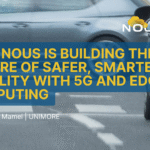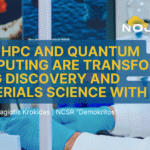Author: Prof. Marco Mamei | UNIMORE
In the heart of northern Italy, a living laboratory is redefining the future of road safety and smart mobility. The Modena Automotive Smart Area (MASA) — an open-air urban testbed — is where cutting-edge research in 5G networks, Edge Computing, AI-powered perception systems and blockchain meets the real world. Here, cars, pedestrians, and city infrastructure continuously communicate, sharing data to make streets safer and mobility more intelligent.
The Challenge: Protecting Vulnerable Road Users
Despite advances in vehicle automation and connected mobility, vulnerable road users (VRUs) — pedestrians, cyclists, and motorcyclists — remain the most exposed in urban traffic. Traditional Vehicle-to-Everything (V2X) systems, which rely on short-range communication, are limited in range and adoption. Ensuring that every road user — not just connected cars — can participate in a safety ecosystem requires a broader, more flexible approach.
This is where 5G Multi-access Edge Computing (MEC) comes into play. By bringing computational intelligence closer to where data is generated, MEC allows cities to detect and predict collisions in real time, combining information from vehicles, mobile devices, and urban sensors.
MASA: A Smart City Laboratory
MASA is not a simulation — it’s a fully operational part of the city of Modena, enhanced with intelligent infrastructure. It integrates:
- Smart Cameras for object detection and tracking;
- Road Side Units (RSUs) for vehicle communication via Wi-Fi and V2X standards (DSRC and C-V2X);
- A dedicated fiber backbone and MEC servers, providing high-bandwidth, low-latency data exchange;
- Cloud platforms for large-scale analytics and mobility intelligence.
In this hybrid environment, every component — from a cyclist’s smartphone to a city camera — becomes a data producer in a connected ecosystem. The architecture links radio and camera domains under a unified computational layer, where MEC nodes fuse heterogeneous data streams in real time.
From Edge to Insight: How the System Works
The fist NOUS use case aims at creating a working prototype of a collision alerting system built on top of MASA’s infrastructure.
Here’s how it works:
- Smart cameras across the MASA area process video streams locally using YOLO-based object detection and DeepSORT tracking, identifying VRUs and vehicles while ensuring GDPR-compliant anonymization.
- Metadata, rather than raw video, are published via the MQTT protocol, creating a city-wide map of mobility patterns, in a fully compliant GDPR way.
- Vehicles and mobile users send GPS coordinates through WebSocket connections to the MEC server.
- The Intelligent Collision Alerting (ICA) algorithm compares trajectories from these different sources, detecting potential intersections and predicting collisions.
- In case of risk, low-latency alerts are sent back to drivers and VRUs through the same network — all within milliseconds.
Field tests demonstrated the system’s ability to accurately identify collision risks and notify users in real time, even using standard commercial 5G connectivity and smartphones — without any dedicated onboard hardware.

The Role of Data Spaces
Behind the technical architecture lies an equally important layer: data governance.
NOUS design embraces the concept of Data Spaces, a European model for federated data sharing. In this framework, each stakeholder — city administrations, telecom operators, industry partners, and research institutions — retains control over its data while contributing to a common, interoperable ecosystem.
This model enables:
- Data sovereignty and clear access rights;
- Semantic interoperability between heterogeneous devices and formats;
- Trust-based collaboration across public and private actors;
- Scalable integration of new sensors (like future radar-based detection systems).
By applying Data Space principles, NOUS ensures that mobility data is not only shared but shared responsibly, aligning with European initiatives for trustworthy AI and digital sovereignty.
Blockchain for Data Integrity and Trust
To ensure that shared mobility data remains authentic, tamper-proof, and auditable, NOUS is experimenting with blockchain-based data management. In a system that depends on multi-stakeholder trust, blockchain acts as a transparent and immutable registry for data exchange, event logging, and access control.
Here’s how blockchain enhances NOUS’s ecosystem:
- Immutable Data Provenance
Every data product — from an anonymized camera detection to a vehicle trajectory — can be hashed and timestamped on the blockchain.
This cryptographic fingerprint ensures that no actor can alter or delete records after publication, enabling forensic traceability of safety-critical events (e.g., collision warnings, system responses).
- Decentralized Trust Between Stakeholders
Instead of relying on a single central authority, MASA’s blockchain layer distributes verification across trusted nodes operated by the city administration, university, and industrial partners.
Each transaction (e.g., data access, algorithmic update, or alert broadcast) is validated by consensus, ensuring trust without central control.
- Smart Contracts for Data Access and Usage
Blockchain-based smart contracts can automatically enforce Data Space policies — defining who can access which data, for what purpose, and under what conditions.
For example, safety applications could have priority access to real-time mobility feeds, while researchers might only receive aggregated, anonymized data snapshots.
- Auditability and Compliance
Regulators and auditors can verify, at any time, who accessed which dataset, and under what authorization.
This improves compliance with GDPR and EU Data Governance Act principles, making MASA a model for transparent and accountable Smart City data management.
- Integration with Edge and Cloud
The blockchain ledger can reside partly at the edge, synchronized with cloud nodes.
This hybrid model enables real-time validation of critical messages — such as collision alerts — while archiving long-term analytics data in the cloud.
The result is a balance between speed, scalability, and verifiable integrity.
Edge Intelligence in Action
At the technical core, MASA’s MEC infrastructure ensures that critical computations — like collision prediction or real-time object detection — occur within 50 to 300 milliseconds. This rapid responsiveness is essential: at 60 km/h, even a 300 ms delay translates to a meter of vehicle movement. Such low latency allows the system to intervene fast enough to matter, enabling proactive collision prevention rather than post-event analysis.
The synergy between edge intelligence and cloud analytics also supports a diverse range of applications beyond safety, such as:
- Mobility analytics and traffic optimization;
- Anomaly detection in road conditions;
- Environmental monitoring;
- Urban digital twins for planning and simulation.
From Research to Real-World Impact
What makes the NOUS demo particularly compelling is its deployability. It runs on commercial 5G networks and standard devices, proving that large-scale safety solutions don’t require proprietary infrastructure. This scalability makes the approach suitable for rapid adoption in European cities, where Smart City projects increasingly converge with telecom innovation.
Looking Ahead
The MASA testbed continues to evolve. Future developments include:
- Integration of radar and LiDAR systems for enhanced environmental perception;
- AI-based path prediction models running on distributed edge nodes;
- Data Space standardization to ensure interoperability with other European smart mobility initiatives.
Ultimately, NOUS-MASA represents a microcosm of Europe’s Smart City vision: a federated, privacy-preserving, and intelligent infrastructure that brings together connectivity, computing, and collective awareness to make urban mobility safer and more efficient.

Conclusion
The combination of 5G MEC, smart perception, and data fusion is not just a technical feat — it’s a new paradigm for urban safety. By merging real-time awareness with scalable data sharing, Modena’s MASA testbed shows how cities can transform raw data into actionable intelligence. As more urban areas adopt similar architectures, the promise of zero fatalities and seamless mobility moves from aspiration to attainable goal.



